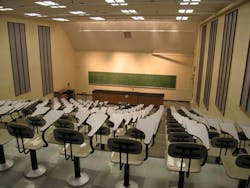Confronting the Campus Steam Conundrum
Introduction
Steam poses a unique challenge for colleges and universities. Many schools want to accurately track, and then internally bill, for steam usage in each of their buildings as part of a wider effort to improve resource management. However, traditional steam metering technologies tend to be a less than optimal choice. Most times, it is necessary to place campus steam meters in the basements of buildings where there is not a lot of room for piping. That causes issues because flow meters typically require significant runs of straight pipe upstream and downstream of the meter to work correctly.
School administrators also encounter issues by trying to measure steam usage during the low-demand summer months. Common vortex meters, which contain a shredder bar mounted across the diameter of a pipe to measure flow, work well at higher flows. When it comes to low flows, however, they can stop working completely due to low flow cutoff problems. Differential pressure (DP) flow meters coupled with the proper electronics, by comparison, can push the low flow cutoff value downward. However, most DP meters can’t get around the straight-run requirements.
Steam system operators can pay a steep price for generating product that passes through a meter but fails to get measured. Also known as low flow cutoff, those losses are a function of the turndown ratio of flow meters. The ratio — defined as the maximum measurement capability of a device compared to its minimum — dictates how wide a flow spectrum can be measured. On campuses, this creates a major issue because demand for steam in the colder weather can be extremely high compared to off-peak times.
The Challenge
An East Coast university designed its system to measure from 167.76 gpm to 16.78 gpm, which accounted for a 10-to-1 turndown ratio and velocities of 420 ft per second to 42 ft per second. After the meter was installed, system operators determined their actual flow range was 39.94 gpm to 2 gpm (a 20-to-1 turndown ratio) and velocities were 100 ft per second to 5 ft per second. Because flow rates were overstated, the university dropped below the low flow cutoff and wasn’t measuring at all during the off-season.
The Solution
The solution was to purchase another meter with a larger cone that would produce more differential pressure at the correct flows. The school has since installed an ExactSteam V-Cone Flowmeter.
Thesis writing is really a struggle for experience pupil. There are fundamental prerequisites for writing the thesis proposal. When writing this document, keep in mind such minutes as period, length, formatting and construction. Such facts are really extremely significant and professors listen to them frequently. Additionally, thesis assistance is obviously needed for pupils focusing on a part-time occupation. Do not hope to write a fantastic thesis immediately. It's a time-consuming procedure.
McCrometer’s ExactSteam solution is designed to overcome those hurdles. The ExactSteam V-Cone Flowmeter works well with short straight-pipe runs, so it addresses the lack of space issues faced by colleges and universities. It also measures steam across the entire range, performing better at lower flows. ExactSteam is a DP-style flow meter that can be adjusted for colleges during winter months. It contains McCrometer’s established V-cone flow meter combined with an electronics package to aid in the downward adjustment of the turndown ratio.
